
About Nanoacts
- Founders: Valery Serbezov and Svetlin Serbezov
- Founded in: 2021
- Employees: 4
- Money raised: -
- Ultimate goal: Provide renewable, clean, cheap energy available anywhere, anytime.
Climate change is an imminent problem that we are all facing today. Greenhouse gas emissions are produced daily due to the high consumption of fossil fuels. Renewable energy is one of the ways to reduce the use of fossil fuels and slow down global warming. Yet despite being renewable, sun, wind, and water are not always reliable and not always available where demand is highest. A couple of Bulgarian scientists have decided to do something about this and tackle this problem, which also led to the birth of Nanoacts. Valery Serbezov is one of the founders of Nanoacts. In this instalment of the start-up-of-the-day series, he brings us up to date with everything that’s important about the company.

How was the idea of Nanoacts born?
“It started 33 years ago, in 1989 when the government first allowed to set up private companies in Bulgaria. We founded a high-tech company. One of the things that we were working on at that time was the development of a sensor for determining color. Then we developed the world’s first sensor for determining color using LED tech. We used it to study the color of children’s food. We conducted experiments with these foods and decided to insert the multimeter test leads into them. So when we removed them, it turned out that they generated voltage. And that really surprised us. The arrow showed a deviation of 20mV-30mV-50mV when we pulled those electrodes out.
Our colleagues didn’t believe it in the beginning, they were saying that this is some sort of a disturbance of the electromagnetic field. Yet after more serious experiments, it turned out that electricity is actually generated. We didn’t know then that baby foods back in 1989 were colloid solutions. Colloid solutions are nano-objects par excellence. Milk is also a colloid solution. But we didn’t know this back in those days. Nanotechnology was not yet popular. One colleague went to America, one to Syria, and I received an invitation and went to Pakistan, so things just didn’t work out then.
In 2020, a colleague of mine and I decided to get back to this topic because it already had started to become more relevant because of the Green Pact, and in light of greenhouse gasses. Without setting up a company, we did the same experiments and used different, more advanced materials. Later on, in 2021, we registered Nanoacts.”

What problem are you solving?
“We can design devices that can be used everywhere, or we can completely democratize the energy platform that right now relies on traditional renewable sources with solar power, hydropower, wind, and thermal energy. These are not constant. We have them when we have wind or sun, and they are not always on site where they are most needed. A transmission network has to be built. Whereas these nanogenerators could, for instance, make use of the movement of fingers on a hand if they were attached to it and could produce electricity that way.”
How does a nanogenerator work?
“Nanogenerators are based on 3 very popular effects in classical physics. The first is the so-called piezoelectric effect. One example is the lighters that feature a piezoelectric stone. When it is struck, mechanical deformation occurs and with this mechanical deformation a potential electric field variance is created and electricity is generated. This is the first effect.
The second effect that can also be explained relatively easily is triboelectricity. When friction occurs, for example when we wear clothing, sparks are produced as a result of the differences in the fabrics.
And the third effect that nanogenerators are based on is pyroelectricity. When there is a difference in temperatures, a regular thermocouple can generate electricity. But when the materials used have a nanostructure, their surface is typically very well-developed, and these effects are visible. This means that devices can be useful products that can be made commercially viable.”
What are some of the applications for your technology?
“The applications for nanogenerators are numerous. They can be used for both personal and industrial applications. We have developed two types of nanogenerators: one has a power output of up to 1 watt. We have been focusing on testing and developing commercial devices for this small nanogenerator that is more suitable for personal use. It can be used to charge smartphones, tablets, shavers, and all kinds of devices. The other type is for industrial applications, especially for Industry 4.0 and IoT; its capacity is up to 100 watts, We will be working more on this nanogenerator in the future.
Nanogenerators can also be used in transport. For example, they can replace batteries and enable the manufacture of cars and planes based on nanogenerators.”
How will the generated energy be stored?
“The devices are 100% self-sufficient, which means they are cable-free, they produce what is needed themselves and store it themselves as well. Such devices combined with sensors don’t need a battery replacement. Unused energy is stored in a special powerful capacitor and can be used when needed.”
What are the conditions like for your start-up in Bulgaria?
“The financing situation in Bulgaria is very difficult, as it is everywhere in the world nowadays, but for different reasons. The problem in Bulgaria is that the venture capital ecosystem is still very new. It is not mature enough yet. People want to make a profit very quickly by investing in software companies. The venture capital companies are also financially very weak. They do not have enough funding for those who want to set up a start-up. These are the key problems and that is why we are seeking funding from other venture capital companies in Europe and looking for other ways and approaches.”

What are you proud of?
“Nanoacts is a very young company, but the best thing we have achieved so far is that we have a very close-knit, responsible team, which includes Daniel Hristov and Hristo Kisov. These are people who are dedicated to this idea, despite the fact that they have gained their experience in different scientific and business fields. The main idea is that we can replace the basis or platform for the traditional renewable electricity producers with an absolutely new platform. By doing that, we will have a direct impact on the removal of carbon dioxide and greenhouse gases, and, in fact, we will be democratizing the energy trade.”
What does the future hold for you?
In our business plan, we have calculated that in around 44 months, we will be ready to be launched on the market. We will either merge with a powerful company that will offer us marketing and sales with already established networks, or we will diversify our products. We will make some new things based on our patents to surprise our customers.”


